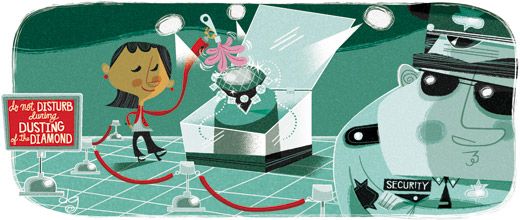Why Do Meteor Showers Occur About the Same Time Every Year and Other Questions From Our Readers
In the latest edition of Ask Smithsonian, we sent your burning questions to the Institution’s curators
So how do you clean the Hope Diamond? -- V. M. Carter, Silver Spring, Maryland
We do it in the morning before the museum opens. It happens about once a week or whenever someone points out that the diamond’s looking a little dusty. Having the Hope Diamond is like having a black polished table in your living room—every bit of dust shows. When dust gets inside that heavily fortified vault, we close down the gallery (with help from the security officers) and open up the vault. Then we just wipe the diamond with a common gem cloth. If it’s a little extra dirty, we use a little alcohol. Then we place the diamond back in the vault and close it up, hoping we don’t jar any more dust loose.
Jeffrey E. Post
Mineralogist, National Museum of Natural History
Why do meteor showers occur about the same time every year? -- Jennifer Uthoff, Pflugerville, Texas
Meteor showers occur only when the Earth’s orbit intersects that of a specific comet, and those intersections occur at fixed intervals.
The Leonid meteors take place when the Earth intersects the orbit of Comet 55P/Tempel-Tuttle, and the Perseid meteors happen when the Earth intersects the orbit of Comet 109P/Swift-Tuttle. It may be helpful to imagine all those diagrams we saw in science class of the solar system from above the plane of the planets. The Earth's orbit was drawn in as an almost complete circle. A comet orbit was often drawn in as a long, elegant ellipse. If we imagine the meteor shower occurs when the orbit of the Earth intersects the cometary orbit, we can see that these showers would not only occur at the same time each year, but also that their duration would be very short. Keep in mind that it is very rare for the orbit of any body in space to intersect the orbit of the Earth. There are hundreds of known short-period comets, and only a handful of meteor showers.
Timothy B. Spahr
Astronomer, Smithsonian Astrophysical Observatory
Why does the Smithsonian never fly the aircraft it restores? -- Joshua Walty, Waynesboro, Pennsylvania
Restoring an aircraft to make it safe to fly requires replacing parts and systems, but the Air and Space Museum’s goal is to preserve artifacts as close to their original condition as possible. Keeping them in non-flying status supports that mission. Critics of this philosophy argue that not flying these aircraft robs us of experiencing them as they were when they were making history, that flying them can afford a fuller understanding of the artifact and how it operates. There definitely is something to be gained when experiencing a great historic aircraft in flight, but it has to be weighed against what is lost in bringing them to flying condition and the potential risk of losing rare specimens in an accident. Also, one-third of our approximately 365 airplanes are one of a kind. If one of those crashed, it would be gone forever.
Peter L. Jakab
Curator of Early Flight National Museum of Air and Space
The artist James Hampton made The Throne of the Third Heaven of the Nations’ Millennium General Assembly out of things like cardboard, tape and aluminum. How do you conserve it so it lasts? -- Thea Joselow, Bethesda, Maryland
The Hampton Throne has what we call “inherent vice”—the materials he repurposed are destined to fall apart. Examples include the joinery methods. To attach paper, foil and cardboard, pins and poor-quality glues were used; heavy wood elements were sometimes joined with thin brads or tacks—not the best choices for sturdy, permanent attachments. Salvaged casters were taken from used furniture, and their jerky movement jars and stresses the Throne elements.
We can’t alter his work, but to prolong its life we can reduce its exposure to light, which fades and degrades materials and adhesives; remove dust, so it doesn’t attract water molecules, which can corrode foils; and clean the Throne, to keep it shiny and true to the artist’s concept of a heavenly setting for salvation.
Helen Ingalls
Objects Conservator Smithsonian American Art Museum
Jazz from the 1920s sounds nothing like jazz today. Why do we use “jazz” for such different music? -- Patrick Leonard, Charlottesville, Virginia
In the past 90 years, jazz has changed tremendously, resulting in a myriad of styles: New Orleans, swing, bebop, cool, hard bop, modal, fusion, Latin jazz and others. The many disparate styles of jazz are linked by melodies with bent or “blue” notes, call-and-response patterns, off-beat and syncopated rhythms, and, finally, improvisation—each time a jazz band plays a piece, it sounds fresh.
John Edward Hasse
Curator of American Music National Museum of American History
What's your question for our curators? Ask now!
